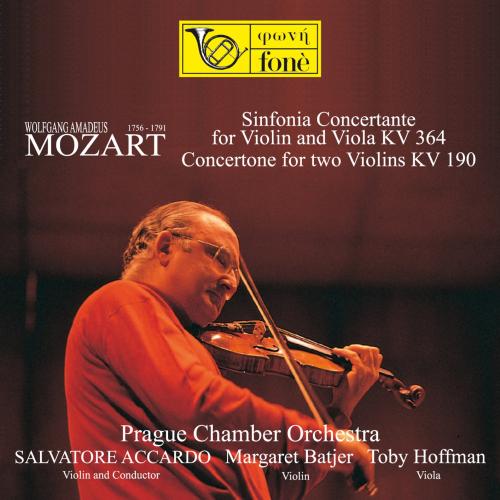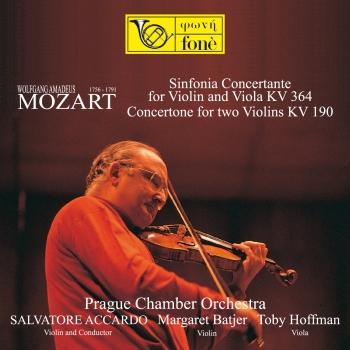
W.A. Mozart: Sinfonia Concertante KV 364 - Concertone KV 190 Prague Chamber Orchestra, Salvatore Accardo, Margaret Batjer, Toby Hoffman
Album info
Album-Release:
2010
HRA-Release:
15.12.2022
Label: fonè Records
Genre: Classical
Subgenre: Concertos
Artist: Prague Chamber Orchestra, Salvatore Accardo, Margaret Batjer, Toby Hoffman
Composer: Wolfgang Amadeus Mozart (1756-1791)
Album including Album cover Booklet (PDF)
- W.A. Mozart (1756 - 1791): Sinfonia Concertante for Violin and Viola E flat major KV 364:
- 1 Mozart: Sinfonia Concertante for Violin and Viola E flat major KV 364: Allegro maestoso 14:19
- 2 Mozart: Sinfonia Concertante for Violin and Viola E flat major KV 364: Andante 11:59
- 3 Mozart: Sinfonia Concertante for Violin and Viola E flat major KV 364: Presto 06:33
- Concertone for two Violins C major KV 190:
- 4 Mozart: Concertone for two Violins C major KV 190,:Allegro spiritoso 09:53
- 5 Mozart: Concertone for two Violins C major KV 190: Andantino grazioso 12:17
- 6 Mozart: Concertone for two Violins C major KV 190: Tempo di Menuetto (Vivace) 09:57
Info for W.A. Mozart: Sinfonia Concertante KV 364 - Concertone KV 190
In the second half of the eighteenth century the Sinfonia Concertante was meant to recover, within the well-consolidated form of the solo concerto, the fascinating instrumental interplay that was proper to the concertino, the group of solo instruments that countered the orchestral tuttis in the baroque concerto. Mozart came into contact with this genre, whose very name suggests something worldly and spectacular, during his second visit to Paris in 1778. In his Concerto for flute, harp and orchestra KV 299 of 1778, the great musician had already discovered all the potential of this double intervention of the solo instrument, and had indeed exploited in an outstanding manner the peculiarity of the timbric effect of the two instruments.
The peculiar and almost impromptu importance of the genre of the Violin concerto in the catalogue of Mozarts musical production is highlighted by the very limited space of time in which the five most important compositions of this type appeared (all within the one year 1775). It is not easy to understand the reason for this constriction in time, especially if we consider that Mozart was one of the few great composers able to play the piano and the violin perfectly; whereas his activity as a virtuoso pianist remained a constant throughout his life, his activity as a concert violinist came to an abrupt and inexplicable end after flourishing so signally in that 1775. Perhaps psychoanalysis alone will shed light on this peculiar aspect of Mozarts creativity, starting with an investigation of the complex relationship that the musician had with his father Leopold, an important violinist and theoretician, author of a seminal treatise (Versuch einer grundlichen Violinschule published coincidentally in the very year in which Wolfgang was born). And yet the notion of an inferiority complex would seem to be contradicted by a famous letter from Leopold to his son: referring to Wolfgangs recent success as a concert violinist in Germany, Leopold writes: Im not at all surprised. You yourself do not realize how well you play the violin. Mozart undoubtedly used the five Violin concertos that he composed in 1775 (KV 207, 211, 216, 218 and 219) for his own activity as a soloist in his home town in Salzburg. Only later did these works become part of the repertoire of the violinist Gaetano Brunetti, who entered the court of Prince Colloredo as official soloist. These concertos, which reflect French style gallant but also borrow from the grand Italian violin tradition, contain some of Mozarts most beautiful and inspired melodies.
Prague Chamber Orchestra
Salvatore Accardo, violin, conductor
No biography found.
Booklet for W.A. Mozart: Sinfonia Concertante KV 364 - Concertone KV 190









